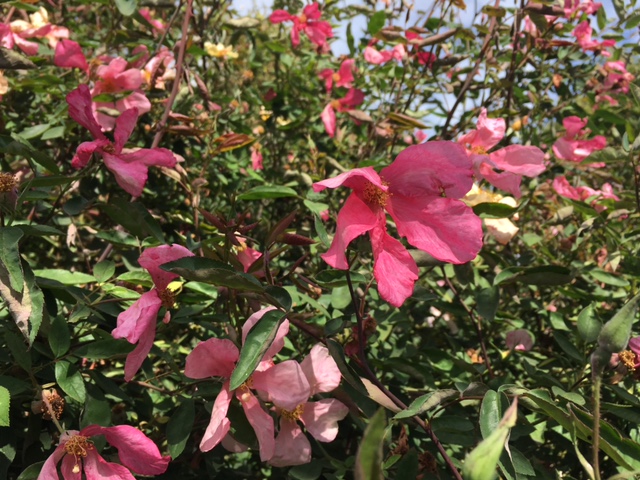
Just one sale this fall, and members get first pick

|
|
The mutabilis rose, an Arboretum All-Star also known as the butterfly rose, is among the plants to be offered for sale during the UC Davis Arboretum Fall Sale. (Photo: Kathy Morrison)
|
The UC Davis Arboretum Nursery plant sale for years has been a top source for California natives and other plants appropriate for our climate. When the Covid-19 shutdowns began, the sales moved online, with curbside pickup arranged for purchased plants.
And that's what is planned this fall, too. Only one sale will be held this season, unlike the multiple ones last spring, and members of Friends of the Arboretum will get first crack at the plant inventory.
And what an inventory! It runs 44 pages, available for viewing here , and includes hundreds of yarrow, dozens of mangaves, 250 showy milkweeds and even a few abutilons. Plenty of succulents, too.
So, if you're already a member of the Friends or of the Davis Botanical Society, be ready at 10 a.m. Tuesday, Oct. 19, when the sale starts. (Such a deal: These folks also get 10 percent off their plant purchase.) Then at 10 a.m. Oct. 22, members of the public will be able to join the shopping. At 1 p.m. Oct. 25, sales will close for the season.
After checkout, shoppers receive a link to schedule a time during the pickup period, which runs from Oct. 26 to Nov. 13, with Sunday, Monday and Veterans Day excluded.
Note: For members of the public to access the online plant sale store, they must sign up for the Arboretum newsletter, The Leaflet. Sign up here. A link to the store will be sent to newsletter subscribers the morning of Oct. 22.
Anyone interesting in joining the Friends of the Arboretum -- which this year is celebrating 50 years of dedicated support -- can find details here. In addition to supporting the Arboretum and Public Garden, which is one of the region's great treasures, and getting deals on plants, members receive other benefits. These include partner discounts at such businesses as Redwood Barn Nursery in Davis, Renee's Garden Seeds online, and Annie's Annuals in Richmond and online.
-- Kathy Morrison
Comments
0 comments have been posted.Sacramento Digs Gardening to your inbox.
Food in My Back Yard Series
May 6: Maintain soil moisture with mulch for garden success
April 29: What's (already) wrong with my tomato plants?
April 22: Should you stock up on fertilizer? (Yes!)
April 15: Grow culinary herbs in containers
April 8: When to plant summer vegetables
April 1: Don't be fooled by these garden myths
March 25: Fertilizer tips: How to 'feed' your vegetables for healthy growth
March 18: Time to give vegetable seedlings some more space
March 11: Ways to win the fight against weeds
March 4: Potatoes from the garden
Feb. 25: Plant a fruit tree now -- for later
Feb. 18: How to squeeze more food into less space
Feb. 11: When to plant? Consider staggering your transplants
Feb. 4: Starting in seed starting
Sites We Like
Garden Checklist for week of May 11
Make the most of the lower temperatures early in the week. We’ll be back in the 80s by Thursday.
* Plant, plant, plant! It’s prime planting season in the Sacramento area. Time to set out those tomato transplants along with peppers and eggplants. Pinch off any flowers on new transplants to make them concentrate on establishing roots instead of setting premature fruit.
* Direct-seed melons, cucumbers, summer squash, corn, radishes, pumpkins and annual herbs such as basil.
* Harvest cabbage, lettuce, peas and green onions.
* In the flower garden, direct-seed sunflowers, cosmos, salvia, zinnias, marigolds, celosia and asters. (You also can transplant seedlings for many of the same flowers.)
* Plant dahlia tubers.
* Transplant petunias, marigolds and perennial flowers such as astilbe, columbine, coneflowers, coreopsis, dahlias, rudbeckia and verbena.
* Keep an eye out for slugs, snails, earwigs and aphids that want to dine on tender new growth.
* Feed summer bloomers with a balanced fertilizer.
* For continued bloom, cut off spent flowers on roses as well as other flowering plants.
* Add mulch to the garden to maintain moisture. Mulch also cuts down on weeds. But don’t let it mound around the stems or trunks of trees or shrubs. Leave about a 6-inch-to-1-foot circle to avoid crown rot or other problems.
* Remember to weed! Pull those nasties before they set seed.
* Water early in the day and keep seedlings evenly moist.